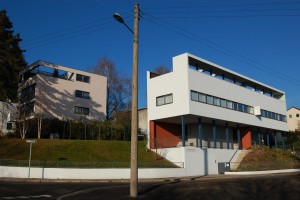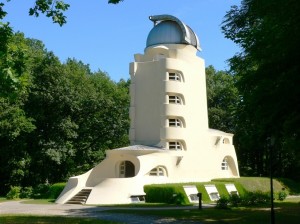After World War I, the Expressionist movement in Eastern Europe gained momentum as a response to the horrors of war. Soon after, Neue Sachlichkeit, or New Objectivity, was responding to Expressionism as a way to bring the people back down to reality and away from the decadence that came with the utopian views of Expressionism. New Objectivity was pioneered by a variety of architects including Ludwig Mies van der Rohe, Le Corbusier, Walter Gropius, Peter Behrens, and Bruno Taut. 1 The term “Neue Sachlichkeit” quickly became loaded with socio-political connotations involving socialism, and thus the Bauhaus and projects such as the Deutscher Werkbund Weissenhofsiedlung became an integral part of the movement. 2

Architect: Le Corbusier
Location: Stuttgart, Germany
Photo by: Jason Karaian
The Weissenhofsiedlung and the Bauhaus helped create a more definitive style for the Neue Sachlichkeit. Dressed in simple exteriors of mostly steel framing, glazed concrete, and glass, as seen in figure 1. When compared to an Expressionist building, such as the Einstein Tower in figure 2, the differences become immediately obvious, down to the very form of the building. 3 In doing away with the lavish decor and non-geometric structures of Expressionism, the housing units could be produced more quickly and cheaply allowing for mass housing projects to begin to take their foothold in society via prefabrication methods, leading to some of the first modernist apartment complexes. This helped the housing crisis still present in Germany after World War I immensely, as many of the renowned architects’ focus had shifted to cheap, efficient, and public. Furthermore, this simplistic and almost minimalist style eventually led to the development of what is known as the International Style. 4

Architect: Erich Mendelhson
Location: Potsdam, Germany
Photo by: Astrophysikalisches Institut Potsdam
With the rise of Nazism, the Neue Sachlichkeit quickly lost its foothold in Germany. The eradication of the social welfare system of the Weimar Republic and the forced emigration of the architects by the Nazis for being deemed socialist, the movement faded and soon after ended. 5 Its legacy, however, is not forgotten between the contributions to social housing, the road it paved for the International Style, as well as the beginnings of modern urban planning. Furthermore, by being such a fundamental force behind the Bauhaus, Neue Sachlichkeit’s importance in not only an architectural context, but in a broad artistic context is not to be understated. Focusing on architecture, it is clear that it was precisely Neue Sachlichkeit that allowed for Functionalism to evolve and grow to rapidly and take such a firm hold on modern architecture.
-SR
Featured Image: Veit Mueller & Martin Losberger, Weissenhod-Luftbild-2004.01. Licensed under CC BY-SA 3.0 via Wikimedia Commons. Available from: Wikimedia, link (accessed November 24, 2015)
Figure 1: Jason Karaian, Le Corbusier Corner, Wiessenhofsiedlung, December 9, 2008. Available from: Flickr, link (accessed November 24, 2015)
Figure 2: Astrophysikalisches Institut Potsdam, Einsteinturm 7443, September 22, 2005. Licensed under Copyrighted free use via Wikimedia Commons. Available from: Wikimedia, link (accessed November 24, 2015)
Notes:
